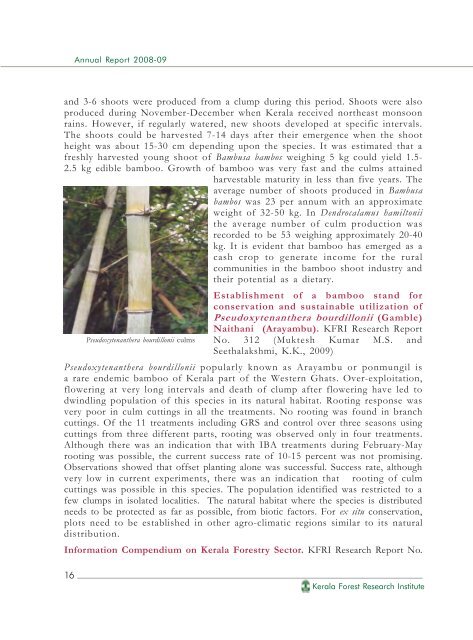2008-'09 - Kerala Forest Research Institute
2008-'09 - Kerala Forest Research Institute
2008-'09 - Kerala Forest Research Institute
You also want an ePaper? Increase the reach of your titles
YUMPU automatically turns print PDFs into web optimized ePapers that Google loves.
Annual Report <strong>2008</strong>-09<br />
and 3-6 shoots were produced from a clump during this period. Shoots were also<br />
produced during November-December when <strong>Kerala</strong> received northeast monsoon<br />
rains. However, if regularly watered, new shoots developed at specific intervals.<br />
The shoots could be harvested 7-14 days after their emergence when the shoot<br />
height was about 15-30 cm depending upon the species. It was estimated that a<br />
freshly harvested young shoot of Bambusa bambos weighing 5 kg could yield 1.5-<br />
2.5 kg edible bamboo. Growth of bamboo was very fast and the culms attained<br />
harvestable maturity in less than five years. The<br />
average number of shoots produced in Bambusa<br />
bambos was 23 per annum with an approximate<br />
weight of 32-50 kg. In Dendrocalamus hamiltonii<br />
the average number of culm production was<br />
recorded to be 53 weighing approximately 20-40<br />
kg. It is evident that bamboo has emerged as a<br />
cash crop to generate income for the rural<br />
communities in the bamboo shoot industry and<br />
their potential as a dietary.<br />
Establishment of a bamboo stand for<br />
conservation and sustainable utilization of<br />
Pseudoxytenanthera bourdillonii (Gamble)<br />
Naithani (Arayambu). KFRI <strong>Research</strong> Report<br />
Pseudoxytenanthera bourdillonii culms No. 312 (Muktesh Kumar M.S. and<br />
Seethalakshmi, K.K., 2009)<br />
Pseudoxytenanthera bourdillonii popularly known as Arayambu or ponmungil is<br />
a rare endemic bamboo of <strong>Kerala</strong> part of the Western Ghats. Over-exploitation,<br />
flowering at very long intervals and death of clump after flowering have led to<br />
dwindling population of this species in its natural habitat. Rooting response was<br />
very poor in culm cuttings in all the treatments. No rooting was found in branch<br />
cuttings. Of the 11 treatments including GRS and control over three seasons using<br />
cuttings from three different parts, rooting was observed only in four treatments.<br />
Although there was an indication that with IBA treatments during February-May<br />
rooting was possible, the current success rate of 10-15 percent was not promising.<br />
Observations showed that offset planting alone was successful. Success rate, although<br />
very low in current experiments, there was an indication that rooting of culm<br />
cuttings was possible in this species. The population identified was restricted to a<br />
few clumps in isolated localities. The natural habitat where the species is distributed<br />
needs to be protected as far as possible, from biotic factors. For ex situ conservation,<br />
plots need to be established in other agro-climatic regions similar to its natural<br />
distribution.<br />
Information Compendium on <strong>Kerala</strong> <strong>Forest</strong>ry Sector. KFRI <strong>Research</strong> Report No.<br />
16<br />
<strong>Kerala</strong> <strong>Forest</strong> <strong>Research</strong> <strong>Institute</strong>

















